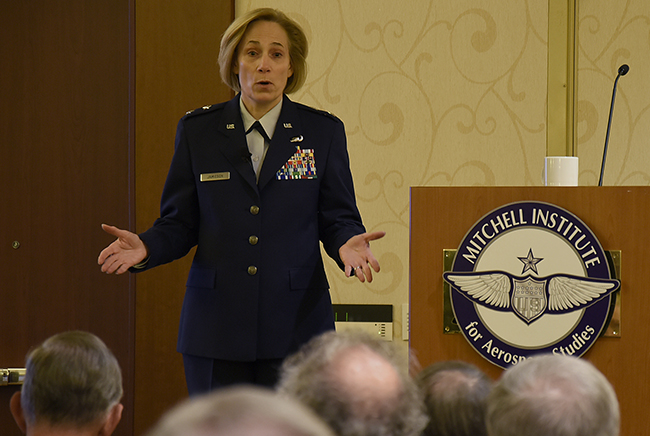
Lt. Gen. VeraLinn Jamieson, the Air Force's deputy chief of staff for intelligence, surveillance, and reconnaissance—shown here during an October 2015 AFA event—discussed the "cyber warfare flight plan" the service is putting together during an appearance at the Intelligence & National Security Summit in National Harbor, Md., on Sept. 4, 2019. Air Force photo by SSgt. Alyssa C. Gibson.
The Air Force is developing a new “cyber warfare flight plan” that will lay out a path for merging various types of intelligence in a secure cloud so airmen around the world can access and analyze it, the service’s top intelligence official said Sept. 4.
Lt. Gen. VeraLinn “Dash” Jamieson, the service’s deputy chief of staff for intelligence, surveillance, and reconnaissance, and cyber effects operations, said the flight plan is looking at how to develop a network that integrates traditional ISR sensors and platforms in each domain with electronic warfare and cyberspace tools to “give us what we call a collaborative sensing grid.”
The Air Force has assets focusing on space, air, surface, subsurface, and cyber, and all that data needs to be put into a network that can be “shared, stored, accessed and secured,” Jamieson said at the Intelligence & National Security Summit in National Harbor, Md.
“Without a hybrid cloud capability, you really can’t operate (artificial intelligence), machine learning, human-machine teaming at the speed and scale of relevance that is required for the great power competition we are in,” Jamieson said.
The Pentagon needs to directly partner with industry, academia, and think tanks to reach that goal, she added.
Jamieson oversaw the rollout of a similar ISR flight plan last year that helped chart the future of the Air Force’s intel-gathering platforms and how the enterprise manages data. This cyber-focused blueprint comes as the Air Force is beginning to align its ISR, cyber, and EW assets under new organizations and management structures. Jamieson, who plans to retire at the end of the year, did not say when the flight plan will be done.
Jamieson also pointed to a pilot program involving the Air Force’s Distributed Ground System in Europe, which processes intelligence data from platforms like the RQ-4 Global Hawk, to focus on the US European Command boss’s top issue. The pilot program has a cross-functional ISR team that is integrating intelligence from the national to the tactical level, she said. She did not elaborate on what the problem set entails.
